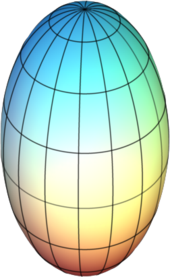Meridian curvature

|

|
| flattened ellipsoid of revolution; Meridians run from pole to pole in both figures |
elongated ellipsoid of revolution |
In geography, the curvature of the meridian is one of two measures for the curvature of the surface of an ellipsoid of revolution .
In contrast to a sphere , where the curvature is the same at every point on the surface and in every direction, in the case of an ellipsoid of revolution it depends on the location and the direction to be observed (the two poles are an exception here , where - as in a sphere - the curvature remains the same in all directions).
The meridian curvature indicates the curvature along a meridian of the ellipsoid of revolution; perpendicular to this, the transverse curvature is a measure of the curvature of the surface. With a combination of meridian and transverse curvature, the curvature can be specified at any point and in any direction on the surface of an ellipsoid of revolution.
At the equator, both curves assume their greatest at the poles each having its smallest value. Important parameters here are the meridional radius of curvature and the transverse radius of curvature .
Web links
- Eric W. Weisstein : Principal Curvatures . In: MathWorld (English).
- Eric W. Weisstein : Principal Radius of Curvature . In: MathWorld (English).